At the turn of the nineteenth and twentieth centuries, using an approach halfway between the anthropological and the occult, the Viennese scholar Guido von List attempted a reconstruction of the Germanic Urgrund, analyzing the more esoteric aspects of the cosmogony and pre-Christian religion of the ancient Central European peoples .
di Marco Maculotti

Guido von List (1848-1919) was a German scholar, poet, journalist, writer and mountaineer. His research work on the origins of the pagan religions of ancient Europe, and in particular his intuitions aimed at deciphering the most esoteric meanings of the entire mythical complex of the ancient Germanic peoples, still constitutes an essential opportunity for anyone wishing to deepen the 'argument, to the point that Marcello De Martino defines it as “the forerunner of the Dumézilian theory” of the Indo-European tripartition, as well as “the exact counterpart of George Dumézil in the occult field”.
However, the admirable results of a lifetime were soon forgotten, not to mention opposed and banished from the entire academic field, as it is believed that List's works had the ominous fault of having greatly influenced, following his death, the transcendental aspect of National Socialist ideology. What is certain is that his research method differed significantly from what, according to the modern scientific paradigm, is considered acceptable and worthy of recognition in our age. In fact, List drew inspiration from the theosophical teachings of Helena Petrovna Blavatsky and he combined the foundations of Gnostic occultism with notions learned from the writings of the secret society of the Rosicrucians, thus managing to outline a historical-religious vision very different from that imposed by modern society. After decades of studying, List came to the conclusion that the entire earth had once been ruled by a caste of priest-kings (i rishis Indians, Celtic Druids), holders of the sacred knowledge he calls Armanenschaft, by means of which they civilized the peoples, giving them a religious cult and a spiritual paradigm of life which would have made possible the maintenance of social peace.
Guido von List: scholar, explorer, clairvoyant

His research field includes Germanic epic literature, which was studied by List in its metaphysical essence, theEdda,Havamal , Volupsa, as well as the esoteric study of the runic alphabet. List also formed a circle of ten people who he called Hoher Armanen-Orden ("High Armanic Order") and organized expeditions throughout Germany in search of the footprints of ancient cults: once there, the group organized meditation sessions, as List believed that the manifestation of true hidden wisdom was usable by the group through meditation practices and fusion with the natural element. In this regard, he referred to his studies on the ancient yogic and tantric practices of ancient India. Many testify to List's actual ability to fall into a trance and receive visions of the ancient lost heritage.
The influence of the orientalist Schlegel

With reference to the doctrines of ancient India, List referred to the studies of Karl Wilhelm Friedrich Schlegel and especially his essay On the language and wisdom of the Indians (1808), in which the author devoted himself to the study of Sanskrit, coming to the conclusion that all the great civilizations known and studied at the time were derived from a single original lineage, the Indo-Aryan one, originally located in the far north of the globe (a legend that is found in almost all ancient mythologies, including those of civilizations that at the time of Schlegel did not yet constitute a subject of academic study, such as for example the pre-Columbian civilizations of Mesoamerica), then migrated southwards during the last great glaciation (about 11.000 years ago) to then divide and settle over the millennia in various territories, such as the fertile crescent, the Indus valley, the Nile valley and, more recently, the Hellenic and Italic peninsula, as well as in the Rhine valley. These conclusions appeared evident to Schlegel by virtue of the innumerable affinities he found between Sanskrit and the Germanic languages, but also with Latin. Furthermore, he derived the idea of the primordial settlement located in the North also from the Indian legends relating to the tradition of Mount Meru, the sacred mountain of the remote North, theaxis beat which is found, punctually in its polar home, in countless ancient traditions—Also of civilizations ethnologically very distant from the Indo-European sphere.
Il Wihinei and the "Christianization of the Ariogermans"
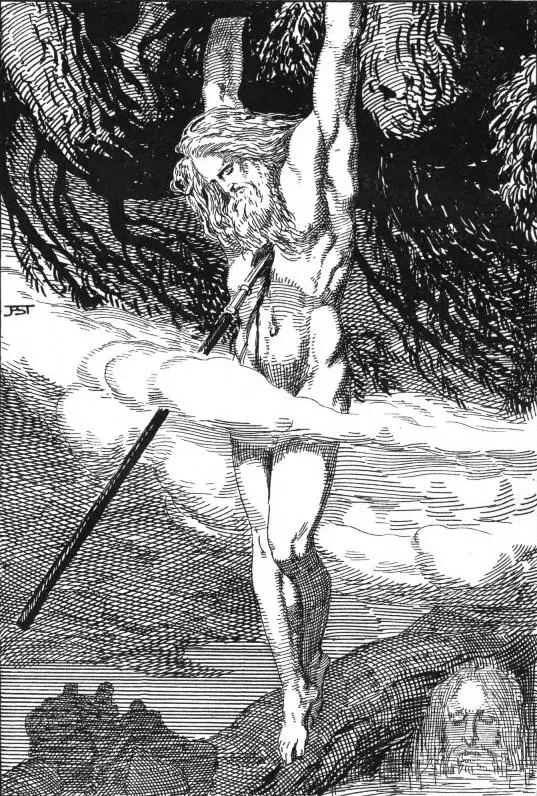
Focusing his research on Christianity, which Europe had long since accepted as an official religion, and comparing the esoteric mysteries and holidays of the Christian calendar with those of ancient paganism, List came to the conclusion that the so-called "Christianization of the Ario- Germani ”was only external, while the cult followed by the ancestors still constitutes the deepest content of Christianity today. He demonstrated his theories with the utmost seriousness, demonstrating in an incontrovertible way the perfect correspondence, etymological and content, of every Christian sacred celebration, not only as regards the major holidays (Yule: Christmas; Ostara: Easter, etc.) but even with reference to the feasts of the saints, and therefore for every single day of the cycle of the sacred year (The concealment of wuotanism in Christianity). According to List, the innumerable correspondences found by Schlegel between Sanskrit and the languages of the ancient European peoples can only lead in a very specific direction: all Indo-European populations derive from an original lineage, which, before the dispersion consequent to the last glaciation, he spoke the same language (which he called Ursprache). List, therefore, accepted the assumptions deriving from Schlegel's studies, but went further: he investigated the esoteric correspondences between the ancient Vedic religious system and the paganism of archaic Europe, thus arriving- following a method that we could define religious syncretism ante-literam—To the reconstruction of the magical-religious complex of the ancient Germans: the Wihinei. The obvious consequence of the detachment from the original language and the adoption of the various vulgar languages deriving from it, caused, according to List, the splitting of traditional knowledge into two separate doctrines: the esoteric one taught to initiates (which the author calls "armanism") and the exoteric one that is easy to understand, based on myth and the anthropomorphization of the gods, for the people (“wotanism”).
The reconstructed cosmogony of the Ariogermans
The primordial mystery is thus described in the song of the ancient myth of the Edda, the Volupsa, quoted by List (The religion of the Ariogermans, p.36), which reads as follows:
Originally there was no sand, no sea, no wind
not the earth below, nor the sky above,
abysmal void, nowhere did grass grow.
Exactly what the ancient Greeks had called Kaos and what modern science, as List notes, calls the "primordial fog": the primordial substance from which all the elements arose. The author then continues:
On that bottomless void of the primordial abyss, closed in on itself, hovered that immeasurable latent force, that uncaused original cause, that impersonal original cause, which can be identified as "the hidden god", as an impersonal, immaterial spirit, which is time and space at the same time. Through one's breath it condenses into matter.
Later in the work (p. 57) List calls this unmanifest god SURTUR ("Stable in the primordial" or "stable in the eternal") "the Dark One", the primordial substance and at the same time the "Great Spirit" that hovers over the darkness of the primordial abyss, the "spirit of salvation", a double mystery that later develops as a "double unity", dividing into a masculine polarity (ALLSATUR, Universal Father, the first Logos, that is to say the god manifested as the "Spirit of the World", creator of all things, demiurge) and in a feminine (hyle, primordial matter / element, cosmic matrix of every being, Great Mother Goddess) [cf. The primordial and triple god: esoteric and iconographic correspondences in ancient traditions]. The esoteric teachings of Armanism reconstructed by List therefore contemplated “a tripartition, or rather a triple state of the concept of God, whereby the original god was represented as androgynous, Namely bisexual"(The religion of the Ariogermans, p.36). In a first phase of creation, List continues, this occult god manifests itself precisely with movement, starting from itself, revealing itself as first Logos, subsequently emanating from itself the first four elements, namely fire (Muspilheim), water (Audhumbla), air (Reflheim) and earth (Play). This primordial act of creation is possible because, detaching the light (the first Logos) from the darkness of the abyss, at the same time that on which the light projects its ray was also detached from the primordial unity, manifesting itself as Hyle, cosmic matter destined to receive. the creative influence of Allsatur and to translate it into the multiplicity of forms of being.
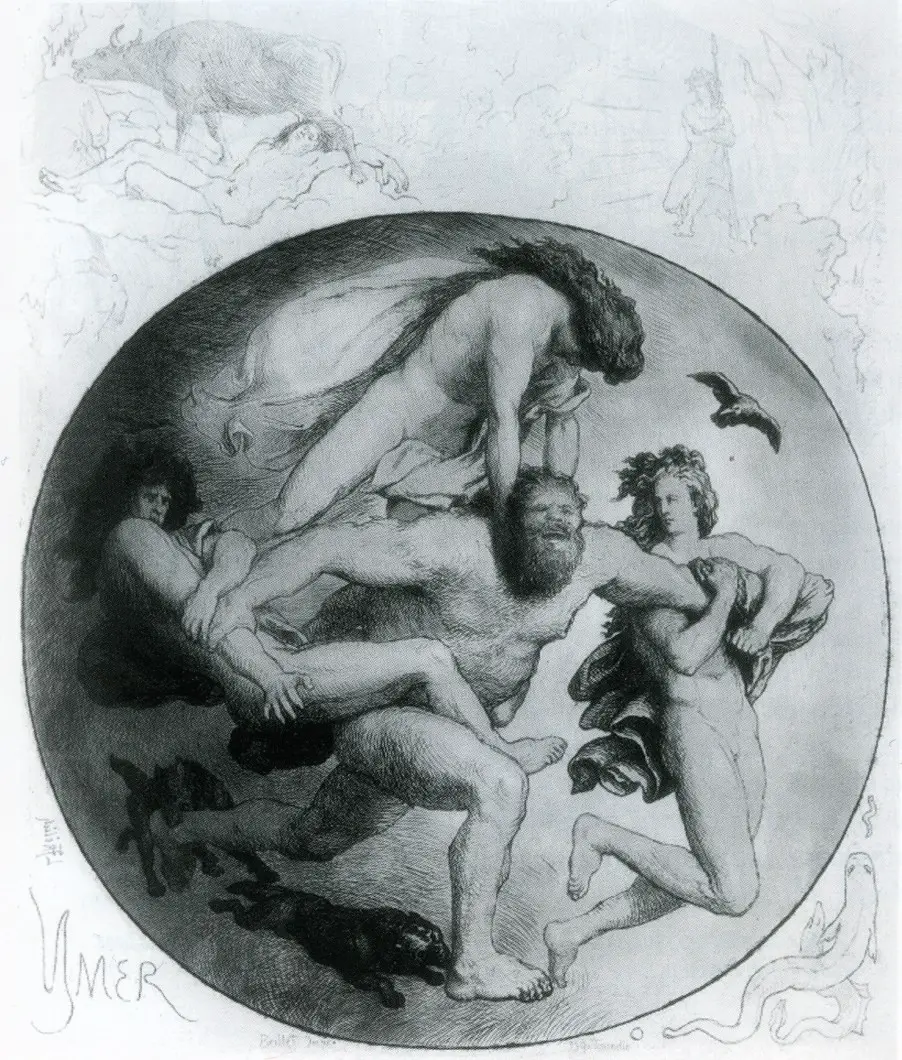
The killing of Imir and the creation of the world
The element Play gave birth to the ancestor of the giants, while the element Audhumbla he generated from the salt stones an androgynous being, Buri, who in turn generated Bör. The latter, joining the offspring of Imir, fathered three sons (Wotan, Wile, We) who killed the giant Imir (or Ymir), “they carried off his body into the empty space between Muspilheim e Reflheim”(Fire and air) and from this they created what we call our world. It is a myth that finds its parallels everywhere in ancient traditions: Imir is the equivalent of the Sumerian-Akkadian Tiamat, of the Greek Typhoon defeated by Zeus and his Olympian brothers, and also of the Aztec goddess Coyolxauhqui (Chalciuhtlicue, Acuecucyoticohuati) [ cf. A cosmogonic reading of the pantheon of the Mexica tradition, in a perspective of religious syncretism]. Comparing the Germanic myth with the Mexica one cannot help but notice the similarities. In the first, it reports List (page 38):
With the killing of Imir so much blood gushed that from his wounds the entire race of the Hrimthursi fell ill, until one named Bergermil ("ancient mountain"), whose father was called Thrudgelmir ("very ancient") and the grandfather Dergelmir ("original") saved himself and his family in a "cradle", which he used to navigate like a boat. In the now restored earthly world he implanted the lineage of giants, which fixed his abode in the lands beyond the sea, which subsequently became the fifth place in which the human lineage settled: Mitgard, the Arctic land, the land located at the north pole, the place of origin of the Ari.
According to Aztec narratives, Chalciuhtlicue / Acuecucyoticohuati was the goddess who ruled the heavens in the age of the fourth sun, that is to say the one before ours. The goddess was very fond of men, but Tezcatlipoca — in typical dress robes trickster reminiscent of the exploits of the Norse Loki — he accused her of masking her selfishness of receiving prayers from men under the pretext of selfless love. Chalciuhtlicue was so affected by this accusation that she wept blood for the next 52 days, causing a terrible flood that drowned all the inhabitants of the Earth. Only a man and a woman are saved, taking shelter inside a cypress trunk. Chalciuhtlicue is later defeated by Huitzilopochtli, who becomes the ruler of the fifth sun. Another myth concerning Huizilopochtli's birth tells of how he faced his sister Coyolxauhqui ("the one with rattles on the face "), killed it and tore it to pieces, creating the new sun, the new moon, the new earth and, perhaps, even today's planet Mars.
The dwarves and the four winds
The planet we live on, therefore, has undergone several metamorphoses over the eons and with it the entire cosmos. This esoteric truth transpires from all the traditional doctrines of the most ancient peoples. Combining the understanding of Germanic-Norse mythology with the study of cosmogony and anthropogenesis expounded by Madame Blavatsky in The secret doctrine, List came to the conclusion that (The religion of the Ariogermans, p.38):
Before men came to earth, this city (Mitgard) prepared for men was inhabited by dwarves, who originally had grown like worms and worms in Imir's dead body, and who subsequently received from the gods the human aspect and spirit, but not the human soul, and inhabited within the earth in dark caverns and crevices.

Later, the gods placed four dwarves as guides of the main winds (Austro: East, Dress up: west, sudri: south, norri: north). The stars and planets were later created — that is, the Asi infused their divine spirits into the seven planets. With this act, says List, "primordial time ended". Reading about this mysterious race of dwarves originating from the dead body of Imir and antediluvian inhabitants of the earth, who now live within it "in dark caverns and crevices", our thinking is automatically led to all that field of legends concerning the "Little People", existing throughout archaic Europe (Scandinavia, Iceland, British Isles, Germany) but also elsewhere (for example, in the traditions of the Native Americans) [cf. The "Little People" in Southeast Native American folklore].
The Ases create the world, Wotan Hänir and Lodur create man

Those whom List calls "gods" are not those of the primordial triad, but the seven Asi which derive from the splitting of the former. According to the author, the Asi (the literal meaning of the term is "columns of the world") create the earth, the seas, the sky, that is the entire visible world, from the body of the killed Imir, "the primordial element" , but not the man, of whom they are able to create only the "figure" (the "scheme" on which the pneuma). They contribute to the creation of the first human couple (Ask and Embla, the Germanic "Adam and Eve") wotan ("Light, spirit, intellect"; the respite) which confers the pneuma spiritual, Hänir (alt. wile; “Light, soul, temperament”; there will) creates the lower soul and intellect e Lodur (alt. We; "Fire, passion, desire"; the original fire) the material body. The divine breath that Wotan injects into the human being is the third Logos, the divine spark present in our interiority.
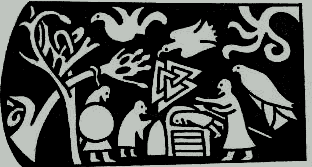
There would be many notes to make: first of all it should be noted that the tripartite division of the human being is typical of the Indo-European tradition. Indeed, it is impossible not to notice the correspondence between Wotan / Hänir / Lodur and the triad of gods Guna in the tradition Hindu, that is the three ultimate components of prakṛti /matter: sattwa (virtuosity, purity, brightness, wisdom), slits (instability, activity, desire) e Thomas (numbness, ignorance, indolence). We also mention the more archaic Latin Triad, studied by Dumézil (The archaic Roman religion), and formed by Jupiter (spiritual principle; caste of priests), Mars (soul principle; caste of warriors) and Quirinus (material principle; caste of producers).
Furthermore, other Germanic traditions call with different names the three gods who contribute to the creation of the human being: if in fact Wotan / Odin is always present, Wile / Hänir is sometimes replaced by Donar / Thor and We / Lodur by Loki, Freyr or Fricco. However, the denomination of Wotan is always found in all the mythical narratives of the ancient Germans since according to List, "he is the most powerful of the triad", he is "the One, the One, the only Being" (p. 38), adding shortly after that:
This One is however the second manifestation, which is realized through the materialization of the divine spirit. He is the second Logos and as such is the Universal Father, who placing himself above Wotan is elusive and unrepresentable, while appearing humanized and representable in Wotan. The Universal Father, also called Dark Surtur (...) is the creator of everything, and Wotan is his humanized counterpart, so he is "one with his father in heaven".
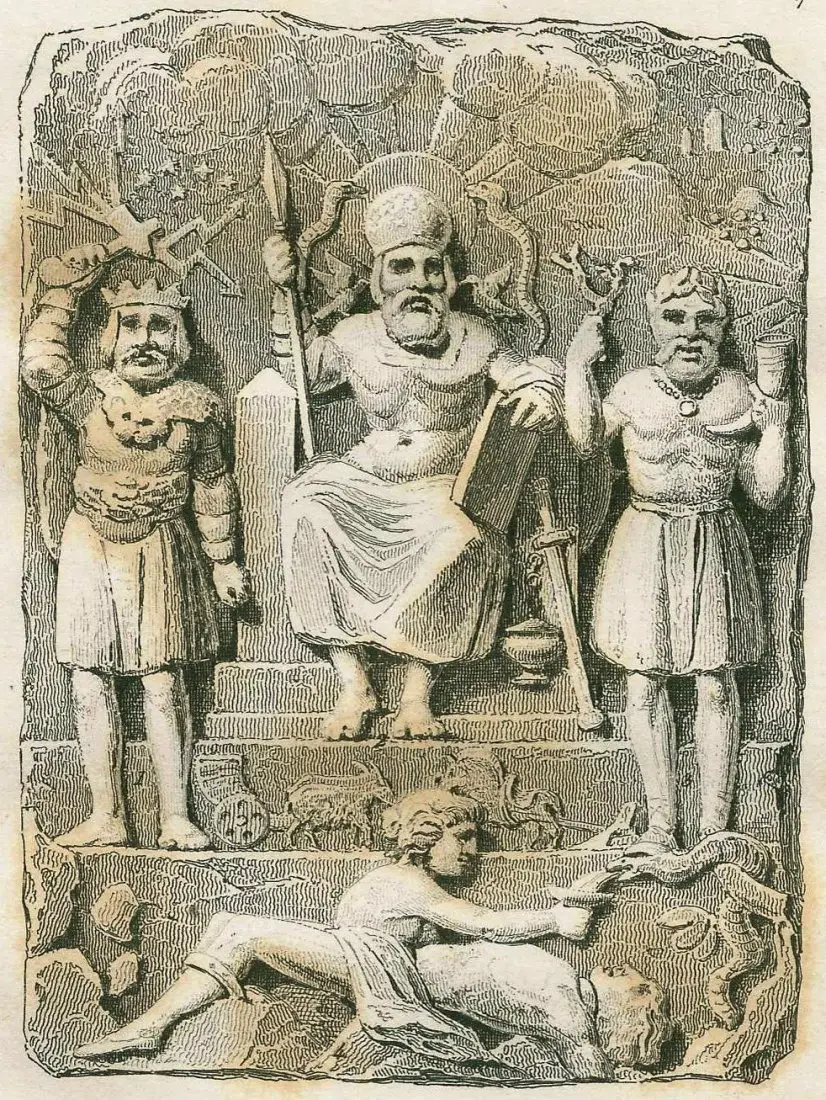
The sacrifice of Wotan, hanging on the Cosmic Tree
The analogies with Christianity don't stop there. The myth tells that Wotan knows the secrets of the runes, the letters which are the very origin of all knowledge and all power. To obtain this wisdom he immolated himself (Wotan second Logos) as a sacrifice to himself (Wotan first Logos) thus becoming the first Erlaz, or the first “runic master. To learn the art of divination and prophecy, Wotan hung on the cosmic Yggdrasill tree for nine days and nine nights. Thus in theHavamál, 139:
I know, I was hung up
to the trunk whipped by the wind
for nine whole nights,
wounded with a spear
and handed over to Wotan,
myself to myself,
on that tree
that nobody knows
where from the roots it rises.

Wotan's wisdom is knowledge, magic and poetry at the same time. He not only knows the mysteries of the Nine Worlds and the order of their lineages, but also the destiny of men and the fate of the universe itself. Perhaps this is why He, unique among the Ases, was able to give a spiritual conscience to the human being: because, by accessing the supreme communion with the Great Mystery, and learning the secrets of the alphabet of the cosmos, He was able to synthesize all and seven spirits of the Aesis in a single spiritual entity, what the ancient Greeks called pneuma. With this magical act Wotan, according to Logos, originated from himself the third Logos, the one who has the power to give spiritual Life to the human being, just as the second Logos self-generated from the First. We must now add that, according to List, i seven gods Asi gave birth to the seven planets: Wotan himself gave birth to Mercury - but Loki also has mercurial characteristics, now presenting himself as trickster now as a cultural hero -, Urfir (or Baldr) to the Sun, Mani / Mannus to the Moon, Tyr / Uncle to Mars, Thor / Donar to Jupiter, Freya / Fena to Venus and the primordial Surtur to Saturn - List speculates that the Latin Saturn is a deformation of Surtur, “stable in the Ur”, that is, in the primordial. In our opinion it can be assumed that Saturn is also Freyr, since, exactly like the Saturn Italic, governs on fertility and the harvest of the fields.

Of these seven supreme Asis, only Wotan can summarize them all, as He is "one with his Father in Heaven". We can clearly see how the pagan myth of Wotan's self-sacrifice was later adopted by Christianity with reference to the figure of Christ, also a god ("firstborn son of God the Father") who sacrifices his life to men: there is no doubt than in Havamal Wotan becomes the protagonist of a real process of death and resurrection. Even the fact that Wotan self-pierces himself with a spear seems to have inspired Christians for the reason for the wounding of Jesus in the side by means of Longinus' spear (also deriving philologically from the mythical “Lugh's spear” in Celtic mythology). There are also evident parallels with the myth of Osiris and with the Aztec one of Quetzalcoatl, who, after having descended to the underworld, stole the "bones" (the runes of the Germanic myth) and dipped them in his own blood to resurrect the human race. Indeed, it is not surprising that, when the populations of Northern Europe were Christianized, the figure of Odin was regularly approached to that of Jesus: depictions of the ancient god are still found today in Christian churches such as the parish church of Akureyri, in Iceland.
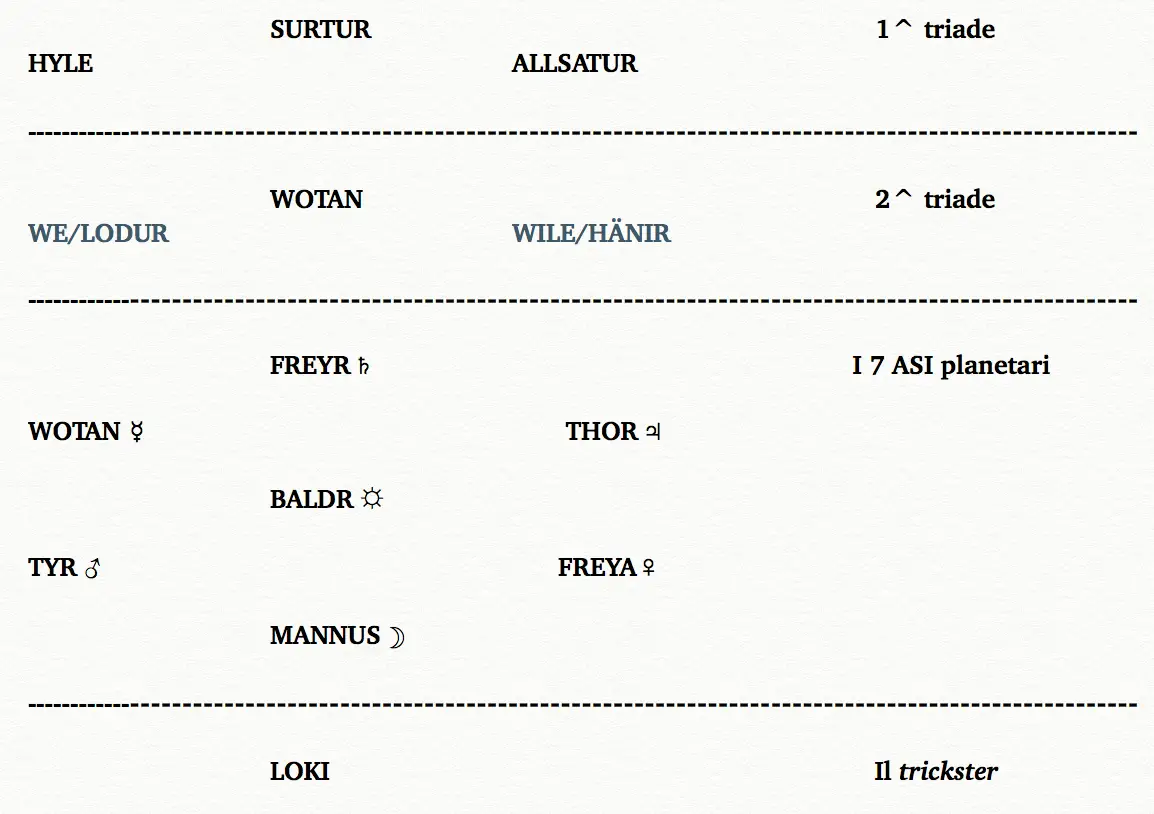
Bibliography:
- Guido von List, The religion of the Ariogermans and Urgrund (Seventh Seal, 2008).
- Guido von List, The secret of the runes (Barbarossa, 1996).
- Guido von List, The concealment of wuotanism in Christianity (Arkthos, 2005).
- Helena Petrovna Blavatsky, The secret doctrine (Italian Theosophical Editions, 2008).
- George Dumezil, The archaic Roman religion (BUR, 2001).
- Jean Markale, Druidism - Celtic religion and divinity (Mediterranean, 1991).
- TGE Powell, The Celts (The Assayer, 1959).

15 comments on “Guido von List and the magical-religious tradition of the Ariogermans"